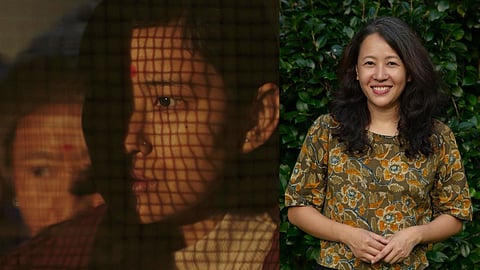Tribeny Rai: Even in the absence of men, women carry the burden of patriarchy
A diploma holder in direction and screenwriting from Satyajit Ray Film and Television Institute and an independent filmmaker from Sikkim, Tribeny Rai’s Nepalese language debut feature film, Shape of Momo, is set to have its world premiere at Busan International Film Festival in the Vision section, followed by European premiere in San Sebastian Film Festival’s New Directors segment.
About Bishnu, who returns to her village in Sikkim after quitting her job in the city and with the dreams of setting up a homestay, only to find herself getting conflicted between tradition and modernity, family expectations, societal pressures and personal freedom. The fulcrum of the film is three generations of women from Bishnu’s family, living under the same roof—her grandmother, mother, herself and her sister, all stubborn and flawed in their own way. Rai pushes the envelope when it comes to the portrayal of gender dynamics while also critiquing the primacy of marriage in women’s lives and the premium placed on baby boys. Is a woman’s worth to be decided by how well she shapes up the momos or whether they taste good irrespective of how they look? Rai talks to CE about all this and more.
How personal is Shape of Momo?
It is deeply personal, not in terms of the situations or the plot, but the characters are drawn from around my family. My close friends have told me that the protagonist—Bishnu—is me. The road came to my house just 4 or 5 years back. I studied in the city, and when I came back to my village, I had to walk almost a kilometre to reach home. That duration in my personal and professional life pushed me towards telling this story. I had just passed out from film school. I didn't know what I was going to do. Most of my friends were leaving for Bombay. My father had passed away. I was the only child left with my mother. My sisters were married. There was a lot of pressure, from the family and the society. People usually take time to make a film about their experiences. But I am an impatient person, whatever is happening, I have to put it out there. Obviously, it required a lot of objectivity, and I think my co-writer, Kislay (Aise Hee) brought that in. It was very different before he came in. I wanted to follow a female character that has a very strong position in the society. So, initially, in my script, the protagonist was a sub-inspector. When Kislay came on board, we started rewriting everything.
The script went through quite a few labs…
We went to Clinik.Kathmandu script lab. We were in the first batch of Filmlab South Asia at Dharamshala International Film Festival. It was held in partnership with Festival 3 Continents’ Produire au Sud (PAS). From there we went to NFDC Film Bazaar in the Work In Progress section, and then we went to Work In Progress Lab of Hong Kong-Asia Film Financing Forum (HAF), to then make its way to Cannes Film Market’s prestigious ‘HAF Goes To Cannes’ initiative this year.
And now it is in Busan and San Sebastian…
I am very excited for Busan because I have seen a lot of cultural similarities between films from that part of Asia and our region. Like the films of [Thai filmmaker] Apichatpong Weerasethakul or [Chinese icon] Jia Zhangke. I'm curious to see how Asian audiences there react to our film.
I will have my first screening in Busan. Then I will leave half of my team members in Busan, and the rest will fly with me to San Sebastian.
There are several thematic strands, the most prominent is of returning home, a simultaneous sense of alienation and belonging it can make you feel…
In the film school you are told that if you have a problem, start making a film about it and eventually you will find an answer. But this process has been nothing like that. By the end of it I only had more questions. I'm still struggling with the fact that I might want to stay with my mother in the village but given my circumstances and my profession, this is not something I can afford to do. But one of the most beautiful things is that the film has resonated with so many of my friends who live in the city or abroad, especially women of my generation, who have to leave their homes and work outside. We will never know what would have happened if we had stayed back.
So, did you shoot the film in your own village?
Yes, Nandok in East Sikkim.
The fear of migrants, the outsider is in the background…
People from the Northeast region complain about how the rest of India is very discriminating towards them. But if you come to our region, you will face the same kind of discrimination. I wanted to highlight that. If it is a house full of women, they’d obviously be scared of men from outside, the strangers, but specifically coming from a particular class and region. The roads in the region are usually built by migrant labourers from Bihar and UP. When I was living with my mother, I would see light in their tent, and it would scare me. Not that they would come and do something, but there was always this fear at the back of my head. I think it is true anywhere. Every society, every community has that fear of the outsider. It is a worldwide experience.
How did you map out the film’s gender portrayal?
When we decided on writing about a house full of women, we knew that we were not going to be self-pitying or nostalgic about the characters. Right from the beginning, we knew that we’d have to be self-critical as well. They are not perfect representations of women. Bishnu the protagonist is very unforgiving. She comes from a place of privilege.
I grew up in a house full of women, I have always seen that even in the absence of men, we carry the burden of patriarchy. They necessarily do not need to be in the room to make us feel like second-class citizens. We are already brought up in such a way, and taught this from when we are little.
My mother sometimes makes me feel like I'm too modern for the village, whereas I feel that she needs to change with time. It is an ongoing battle. Sometimes I feel that my generation does not offer our parents the same kind of patience and empathy that we offer ourselves. So my favourite scene in the film is when the protagonist gives a chance to her mother to tell why she's the way she is.
The grandmother is memorable…
I have felt that after a certain age women in the society stop being women. They start getting treated like men. An old woman can take a bath outside, nobody would care. She can smoke bidi or cigarettes. After a certain age, the women also enjoy that same social freedom that men do.
There are elements of scatological humour. Women are not supposed to talk about bodily functions but you've tried to push the envelope by making them do so in a delightful, intimate dining table conversation…
It’s a space of solidarity, the dynamics you see among women when there is no male gaze on them. When women are left on their own.
From what I gather from the film, electronic devices seem to be an obsession in Sikkim…
Mobiles, notebooks, karaoke. All these things have become an integral part of our society and community in Sikkim. Every party you go to, there's a karaoke set where people are singing, and older people are watching. They are watching videos on iPad. Every other person has become a vlogger here. That is how they're making money right now. We thought that it is very important to put these details so that 20 or 30 years down the line, people will not just remember the film for its plot, but for these changes they saw.
So, has Korean popular culture also spread in Sikkim?
I think K-pop is the most popular brand of music in the Northeast. Because we look a certain way, we do not relate with the hero and heroines of the Indian mainland cinema. We find more similarities with the Korean pop stars. We can see ourselves in those stars.
Tell me about your process of casting..
I think we were, in the beginning, just trying to look for the actors who would look the parts. I was very firm about trying to find someone who’d look like me to play the protagonist. I've never seen someone who looks like me in the films. I felt I had to change it for the coming generation. I had to put a hero in the film who looks like us so that people can feel it’s their story. More or less all the actors in the film are professionals. Gaumaya Gurung who plays Bishnu and Pashupati Rai, the mother, were both in Deepak Rauniyar’s Pooja Sir. But the grandmother is played by one of my relatives. She sadly passed away 3-4 months back.
How is cinema shaping up in Sikkim presently?
Our population is very small. By default, we have to depend on Nepal and the Nepali diaspora. There have been filmmakers who have done really well, but over the last decade, there have been fewer films made, but it is slowly catching up and people are making a lot of films. Sikkim is also tied to North Bengal, because a lot of Nepali population lives there. So, if you put Darjeeling, Kalimpong, and Sikkim in perspective, I think it's doing really well now.
A lot of filmmakers are coming up, and a lot of aspiring filmmakers have gone to institutes like FTII and SRFTI, so now we have a group of our own where we can actually lean onto each other and continue making films.


